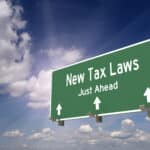Earlier this summer, the U.S. Supreme Court issued its opinion in South Dakota v. Wayfair, stating that a physical presence is no longer required to establish substantial nexus in the collection of sales and use tax. Now, it’s an “economic nexus” that establishes the need to collect sales tax.
This case will have implications for many online sellers and multistate businesses. If you are currently only selling through Amazon and to resale customers, then this will not affect you. However, if you have created your own online sales platform, and if you sell direct to consumers vs. resale stores, this will become relevant.
Out-of-State Sales Impact
Businesses that ship or electronically deliver products to customers outside of the state in which they have a physical location will need to reevaluate their state and local sales tax collection and remittance policies and procedures.
The Court ruled that a state can require an out-of-state seller to collect sales or use tax on sales to customers in that state, even though the seller lacks an in-state physical presence.
Under certain circumstances, an economic or virtual presence can create nexus (a sufficient connection with the state), subjecting a seller to tax collection and remittance requirements in a state. In some cases, a company’s electronic apps or website tracking “cookies” may be considered a nexus – creating presence in a state.
Currently, 34 of the 50 states have adopted an economic nexus threshold. It’s expected that the remaining states will follow suit in 2019 when the state legislatures are back in session. The thresholds for each state vary, so businesses need to monitor each state separately.
As an example of how it works – many states have adopted thresholds of $100,000 gross sales, or 200 separate sales transactions. If either of those thresholds are reached within a calendar period, you are expected to register in the state and begin collecting and remitting sales tax.
Next Steps:
Check that you have up-to-date tax exemption certificates for all of your resale customers.
- Ensure sales software has the ability to track customer sales by state. Both the gross sales and number of customer sale transactions will need to be monitored.
- Verify that sales software has the ability to enter multiple sales tax jurisdictions, as tax rates will vary.
- Create a monitoring process (quarterly) and run reports to gauge whether the sales thresholds have been reached. Most states have an administrative enforcement date of October 1, 2018, so this becomes important as businesses move into the fourth quarter and into future calendar years.
- Ensure you’re not spending more than necessary. A food and beverage manufacturer, for example, is exempt from sales tax when purchasing ingredients or other raw materials, but with the changes in law the business may find more suppliers adding sales tax to invoices. Manufacturers will need to train staff to monitor the raw material invoices to ensure they are not paying sales tax in error. Businesses will need to provide a resale exemption certificate to the supplier, so make sure it’s up-to-date and easy for staff to locate.
For assistance with determining each state’s economic nexus threshold, and the impact on your business’ sales tax, contact a K∙Coe Isom tax expert.











